European Memories
of the Gulag
ToPics
Setting the pattern for “special settlements”
More than one hundred operations of deportation were undertaken during the Stalin period, but the largest by far was the first mass deportation of Soviet peasants. In 1930 and 1931, more than 1,800,000 kulaks allegedly hostile to collectivisation were “exported” from grain-rich regions to the inhospitable lands of the Russian Great North, Urals, Siberia and Kazakhstan. This special colonisation, as the police called it, was nothing other than a punitive colonisation intended to exert control over the enemy and the territory. The aim was to re-educate the former by exploiting the latter.
“Dekulakisation” led to the setting up of the system of special settlements that from late 1931 to the end of the 1950s was to become a huge administrative machine designed to manage the special resettlers, the typical products of Stalin’s Great Turning.
Dispossessed of all their property, uprooted with their families, placed under house arrest in villages supervised by an NKVD commandant, subjected to forced labour, such was the fate of these new excluded victims whose sentences were of indefinite length.
This first mass deportation was an experiment that set the pattern for the history of Soviet purges and foreshadowed the routine forced displacements of population within Stalin’s USSR.
On Stalin’s death, there were in the Soviet Union more than 2,800,000 special settlers. They each belonged to one of the thirty categories the authorities had over the years defined by social, ethnic, religious, political or purely geographical criteria.
-
Initial housing for peasants exiled to the North
Construction of the Makarikha transit camp in February, Kotlas district. Photo from an album produced by the NKVD on the construction of a village by peasants who were victims of dekulakisation. (Photograph, Anonymous, 1930). Source: Archives of the UVD of the Arkhangelsk Region.
Media subject to copyright.
Winter wheat warehouses converted into barracks for deportees, town of Kotlas. Photo from an album produced by the NKVD on the construction of a village by peasants who were victims of dekulakisation. (Photograph, Anonymous, 1930). Source: Archives of the UVD of the Arkhangelsk Region.
Media subject to copyright.
Peasant women at work grubbing the land for cultivation. Photo from an album produced by the NKVD on the construction of a village by peasants who were victims of dekulakisation. (Photograph, Anonymous, 1930). Source: Archives of the UVD of the Arkhangelsk Region.
Media subject to copyright.
Interior of a barrack. Photo from an album produced by the NKVD on the construction of a village by peasants who were victims of dekulakisation. (Photograph, Anonymous, 1930). Source: Archives of the UVD of the Arkhangelsk Region.
Media subject to copyright.
Akan special village, Onega district. Photo from an album produced by the NKVD on the construction of a village by peasants who were victims of dekulakisation. (Photograph, Anonymous, 1930). Source: Archives of the UVD of the Arkhangelsk Region.
Media subject to copyright.
BuildConstruction of collective housing in deportee villages. Photo from an album produced by the NKVD on the construction of a village by peasants who were victims of dekulakisation.ing collective housing in deportee villages (Photograph, Anonymous, 1930). Source: Archives of the UVD of the Arkhangelsk Region.
Media subject to copyright.
Temporary camp before final construction of the villages. Photo from an album produced by the NKVD on the construction of a village by peasants who were victims of dekulakisation. (Photograph, Anonymous, 1930). Source: Archives of the UVD of the Arkhangelsk Region.
Media subject to copyright.
Building a road to special villages. Photo from an album produced by the NKVD on the construction of a village by peasants who were victims of dekulakisation. (Photograph, Anonymous, 1930). Source: Archives of the UVD of the Arkhangelsk Region.
Media subject to copyright.
Temporary barracks for deported families, Cheleksa, Plesetsk district. Photo from an album produced by the NKVD on the construction of a village by peasants who were victims of dekulakisation. (Photograph, Anonymous, 1930). Source: Archives of the UVD of the Arkhangelsk Region.
Media subject to copyright.
CloseInitial housing for peasants exiled to the North
These photographs are taken from an NKVD propaganda album preserved at the police information centre in Arkhangelsk. This is an exceptional source, because images of the Stalin deportations are few in the archives.
Entitled Labour villages in the North region and Komi ASSR from 1930 to 1937, the album contains more than three hundred photographs taken by the NKVD during two distinct periods; the initial deportation phase (1930-1931) and 1936, the year of Stalin’s Constitution and the assertion of victory over the enemy. They illustrate the eleven topics the book covers: moving in, building the villages, reclaiming the land, livestock, farm buildings, production work, crafts, daily and cultural life, schools, kindergartens and medical services.
In the manner of a Soviet secret report, but in pictures, the NKVD regional hierarchy enthusiastically describes the great progress made in seven years by its departments charged with implementing the special settlement.
Was it a gift-album for the twentieth anniversary of the Revolution, or a back-covering paper trail to protect the jobs of those who produced it? There is no indication of the motives behind this internal propaganda. However, the message conveyed is explicit: the inhospitable lands have been brought under control and the enemies re-educated.
Apart from its propaganda value, the album does not fully succeed in concealing the essential facts: the harshness of the environment, the bareness of the housing, the distress of the deportees forced not only to camp in mid-winter, but also to leave their shelters to pose for the cameras of their persecutors.
The slideshow follows the trajectory of the exiled deportees and shows their initial housing.
The descriptions are based on the facts contained in the album captions.
-
 “Sovietisation” in black and white
“Sovietisation” in black and white
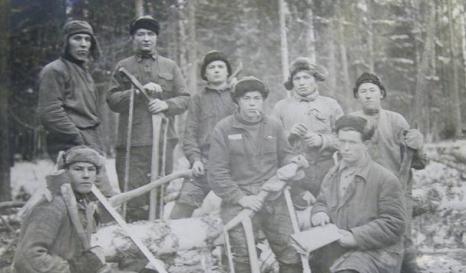
A brigade of labour settlers assigned to slaughter. Photo from an album produced by the NKVD on the construction of a village by peasants who were victims of dekulakisation. (Photograph, Anonymous, 1938). Source: Archives of the UVD of the Arkhangelsk Region.
Media subject to copyright.
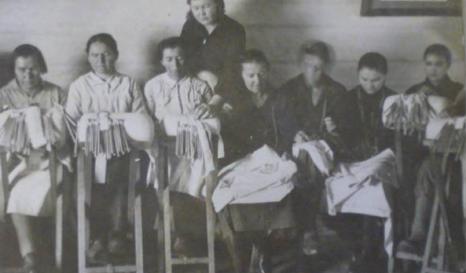
A brigade of lacemakers and embroiderers from the special artel in Churilosk, Totma. Photo from an album produced by the NKVD on the construction of a village by peasants who were victims of dekulakisation. (Photograph, Anonymous, 1936). Source: Archives of the UVD of the Arkhangelsk Region.
Media subject to copyright.
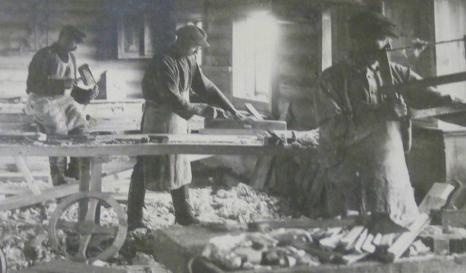
Carpentry workshop in a labour village. Photo from an album produced by the NKVD on the construction of a village by peasants who were victims of dekulakisation. (Photograph, Anonymous, 1936). Source: Archives of the UVD of the Arkhangelsk Region.
Media subject to copyright.
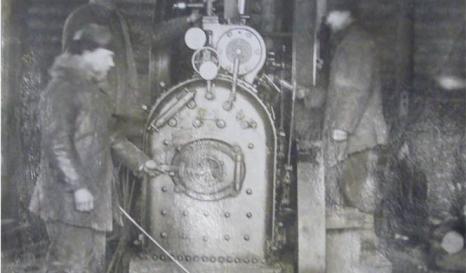
A locomobile. Photo from an album produced by the NKVD on the construction of a village by peasants who were victims of dekulakisation. (Photograph, Anonymous, 1936). Source: Archives of the UVD of the Arkhangelsk Region.
Media subject to copyright.
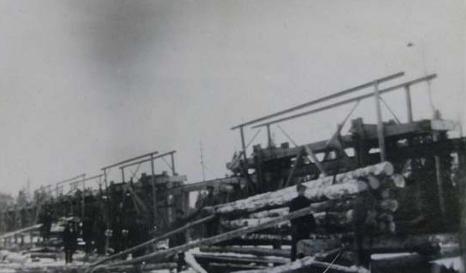
Overhead railway for suspended railway for lumber transport. Photo from an album produced by the NKVD on the construction of a village by peasants who were victims of dekulakisation.lumber transport (Photograph, Anonymous, 1936). Source: Archives of the UVD of the Arkhangelsk Region.
Media subject to copyright.
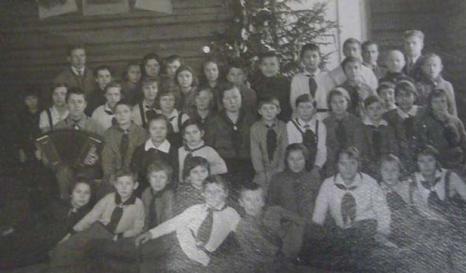
A detachment of pioneers in the labour village's school. Photo from an album produced by the NKVD on the construction of a village by peasants who were victims of dekulakisation. (Photograph, Anonymous, 1936). Source: Archives of the UVD of the Arkhangelsk Region.
Media subject to copyright.
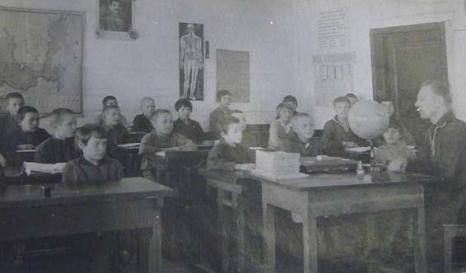
Children of "labour settlers" in a classroom. Photo from an album produced by the NKVD on the construction of a village by peasants who were victims of dekulakisation. (Photograph, Anonymous, 1936). Source: Archives of the UVD of the Arkhangelsk Region.
Media subject to copyright.
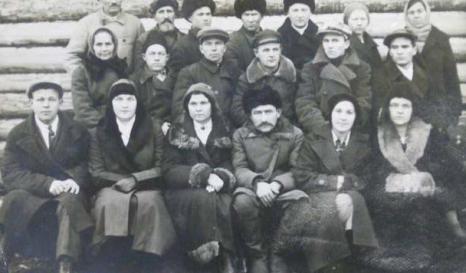
Activists in a labour village. Photo from an album produced by the NKVD on the construction of a village by peasants who were victims of dekulakisation. (Photograph, Anonymous, 1936). Source: Archives of the UVD of the Arkhangelsk Region.
Media subject to copyright.
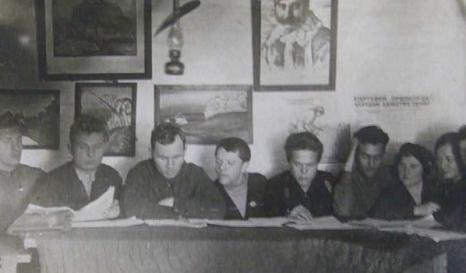
A club of labour colonists studying the decisions of the 7th Extraordinary Congress of Soviets of the USSR. Photo from an album produced by the NKVD of the construction of a village by peasants who were victims of dekulakisation. (Photograph, Anonymous, 1936). Source: Archives of the UVD of the Arkhangelsk Region.
Media subject to copyright.
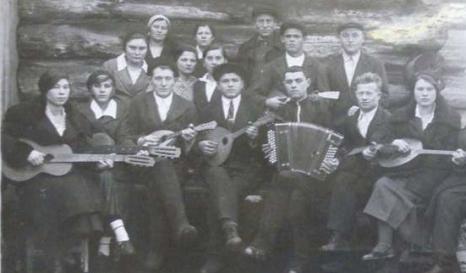
Amateur musicians’ group in a labour village. Photo from an album produced by the NKVD on the construction of a village by peasants who were victims of dekulakisation. (Photograph, Anonymous, 1936). Source: Archives of the UVD of the Arkhangelsk Region.
Media subject to copyright.
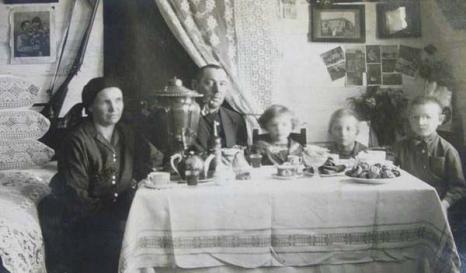
The labour settlers’ new daily life. Photo from an album produced by the NKVD on the construction of a village by peasants who were victims of dekulakisation.aily newspaper (Photograph, Anonymous, 1936). Source: Archives of the UVD of the Arkhangelsk Region.
Media subject to copyright.
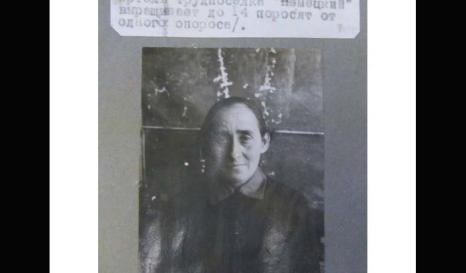
Stakhanovist Befort A. R. Photo from an album produced by the NKVD on the construction of a village by peasants who were victims of dekulakisation. (Photograph, Anonymous, 1936). Source: Archives of the UVD of the Arkhangelsk Region.
Media subject to copyright.

Stakhanovite Lavrentev A.P. Stakhanovist Lavrentev A. P. Photo from an album produced by the NKVD on the construction of a village by peasants who were victims of dekulakisation. (Photograph, Anonymous, 1936). Source: Archives of the UVD of the Arkhangelsk Region.
Media subject to copyright.
Close“Sovietisation” in black and white
All that is missing in the NKVD album is colour (see photo section “Initial housing for peasants exiled to the North”) to show what the authorities meant by “Sovietisation”.
The caption alone is quite clear, “Labour villages are a school for re-moulding”, and the picture is no less eloquent. In exile as elsewhere, the collective ruled and work could only be done in brigades, whether of women or men. Collective effort and pride in mechanisation are recorded for posterity.
Soviet social values are conveyed by the involvement of “ex-kulaks” in the various integrationist institutions: a group of Pioneers or schoolchildren, a club of busy activists under Stalin’s watchful eye, or a group of amateur musicians.
The image of a family in their Sunday best sitting around a well-decked table is a perfect allegory of social achievement. Less successfully posed are the portraits of individuals raised to the rank of “Stakhanovite” for having learnt a skill during their re-education. Don’t these rare photographs of A.R. Berfort and A.P. Lavrentev, looking like recently arrested prisoners, belie the NKVD’s message?
The captions are taken from the NKVD album.
The last two captions include the typed citation:
12. Stakhanovite Befort A.R. “Pig-breeder in the special artel of Nemetsky labour village, she reared fourteen piglets from a single litter.”
13.Stakhanovite Lavrentev A.P. “Horticultural gardener in Nemetsky labour village. In 1936, he was awarded 75 roubles by the exhibition committee for his results in horticulture.”
-
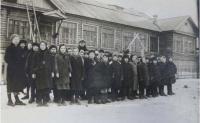 Visible signs of Soviet progress
Visible signs of Soviet progress
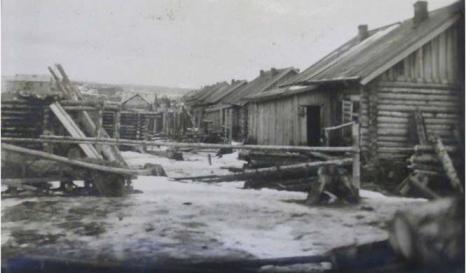
Norminga labour village, Konosha district, North region (Photograph, Anonymous, 1930-1931). Source: Archives of the UVD of the Arkhangelsk Region.
Media subject to copyright.
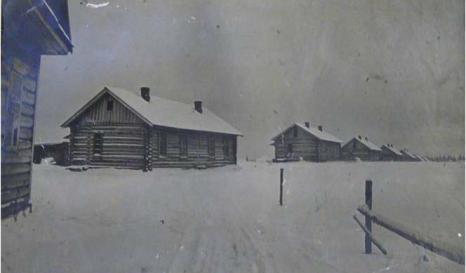
Two-family houses of the type found in labour villages in North region (Photograph, Anonymous, 1937). Source: Archives of the UVD of the Arkhangelsk Region.
Media subject to copyright.

Children’s hut in a special settlement in Plesetsk district (Photograph, Anonymous, 1930). Source: Archives of the UVD of the Arkhangelsk Region.
Media subject to copyright.
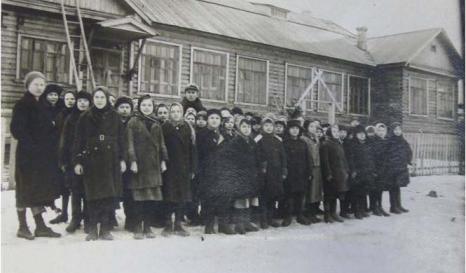
Pupils outside the school in a labour village (Photograph, Anonymous, 1937). Source: Archives of the UVD of the Arkhangelsk Region.
Media subject to copyright.
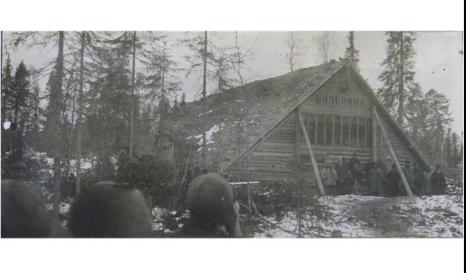
Hospital in a special settlement (Photograph, Anonymous, 1930). Source: Archives of the UVD of the Arkhangelsk Region.
Media subject to copyright.
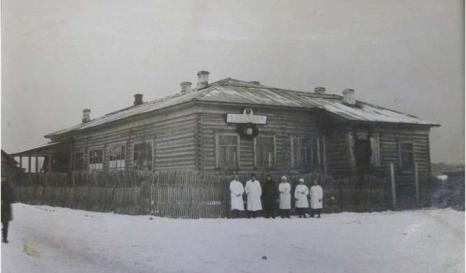
Hospital in a labour village (Photograph, Anonymous, 1937). Source: Archives of the UVD of the Arkhangelsk Region.
Media subject to copyright.
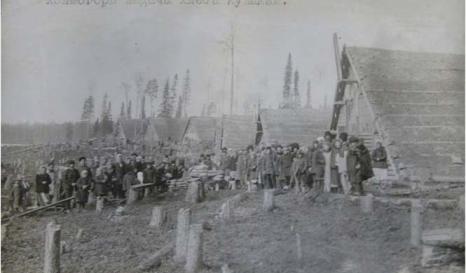
Distribution of bread to kulaks, Kholmogory district (Photograph, Anonymous, 1930). Source: Archives of the UVD of the Arkhangelsk Region.
Media subject to copyright.
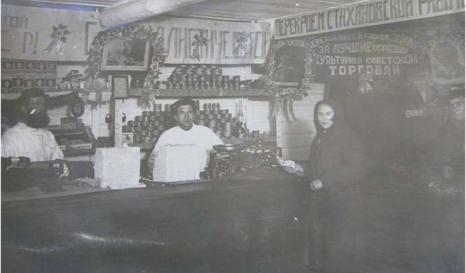
Shop in a labour village (Photograph, Anonymous, 1937). Source: Archives of the UVD of the Arkhangelsk Region.
Media subject to copyright.

Cowshed when special settlements were being built (Photograph, Anonymous, 1930). Source: Archives of the UVD of the Arkhangelsk Region.
Media subject to copyright.
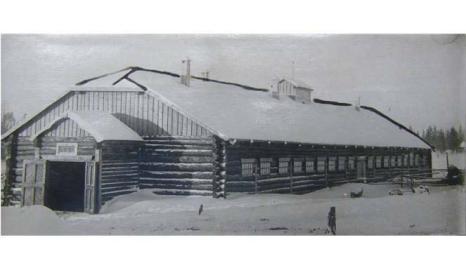
Cowshed in a labour village (Photograph, Anonymous, 1937). Source: Archives of the UVD of the Arkhangelsk Region.
Media subject to copyright.

Tar kiln in a labour village (Photograph, Anonymous, 1937). Source: Archives of the UVD of the Arkhangelsk Region.
Media subject to copyright.

Clubhouse in a labour village (Photograph, Anonymous, 1937). Source: Archives of the UVD of the Arkhangelsk Region.
Media subject to copyright.
CloseVisible signs of Soviet progress
The representation of Soviet achievements is not always dominated by the colossal proportions of Gulag projects or major industrial complexes of the Stalin era. More modest works also contributed to building progress, as can be seen from these little Soviet oases in the middle of the taiga.
The NKVD propaganda album these photos are taken from (see “Initial housing for peasants exiled to the North”) vaunts Soviet success by contrasting the organised chaos of 1930 with the happy completion of the new village at the end of the decade.
The village institutions shown (school, hospital, club, shop, factory, etc.) provide the necessary framework for the smooth running of these deportee villages, built from scratch. The way they are paired in this album is further evidence of what success meant to the authorities of the 1930s.


